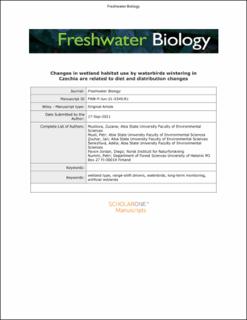| dc.description.abstract | 1. Understanding species habitat use and factors affecting changes in their distribu-tions are necessary to promote the conservation of any biological community. We evaluated the changes in wetland use of the non- breeding waterbird community. Based on long-term citizen-science data (1988–2020), we tested the hypotheses that wetland use is associated with species diet and potential range-shift drivers (the tendency to occupy the same sites in consecutive years—site affinity—and the species' average temperature across its wintering range—species temperature index).2. We analysed species-specific wetland use of 25 species of waterbirds wintering in Czechia over a period of 33 years. The analyses explained variability in trends in numbers of the studied waterbird species across four inland wetland types: reser-voirs; fishponds; industrial waters created by flooding of former mining sites; and running waters.3. Trends in waterbird abundance positively correlated with species’ diet on fish-ponds, industrial and running waters. Among the diet groups, invertivores showed the largest increase in abundances on industrial waters, closely followed by her-bivores. Herbivores showed the largest increase in abundances in fishponds, and piscivores did so in running waters. Regarding range-shift drivers, species with higher site affinity showed higher abundances on running waters, while species with low species temperature index (i.e. wintering on average in sites with lower temperature) were more abundant on reservoirs. The abundance of both warm- dwelling and species with low site affinity increased on fishponds and industrial waters.4. Our findings suggest that the increased importance of the wetland types consid-ered here for wintering waterbirds is likely to be linked to diet related changes in habitat use and changes in species distributions; and highlight that wintering waterbirds are expected to select sites with higher availability of food, higher en-ergy content, and lower foraging cost.5. Recent and rapid changes in species distributions may lead to a decrease in the effectiveness of national and international conservation efforts. When planning conservation measures, it should be kept in mind that climate change does not only imply large-scale north/north- eastwards shifts of entire waterbird distribu-tions, but can also modify the use of the habitats by waterbird species inside their traditional wintering range. artificial wetlands, long-term monitoring, range-shift drivers, waterbirds, wetland type | en_US |
